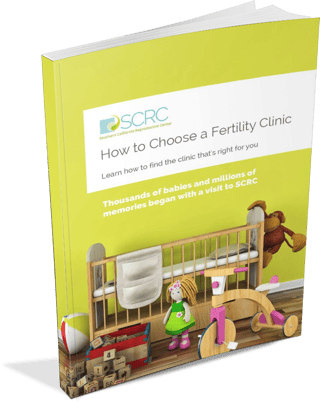 The buzz about elective egg freezing keeps growing, but public opinion is still split. Half the articles you see on the subject champion egg freezing as a huge leap forward in choice, freedom, and equality for women. The other half seem to raise serious questions about how effective the procedure is and whether the success rates make it worthwhile. If you do make the decision to freeze your eggs, how likely is it to pay off in a healthy baby when you’re ready?
The buzz about elective egg freezing keeps growing, but public opinion is still split. Half the articles you see on the subject champion egg freezing as a huge leap forward in choice, freedom, and equality for women. The other half seem to raise serious questions about how effective the procedure is and whether the success rates make it worthwhile. If you do make the decision to freeze your eggs, how likely is it to pay off in a healthy baby when you’re ready?
When it comes to fertility treatment, no responsible clinic will give you a 100% guarantee that freezing your eggs now will result in pregnancy and live birth when you decide to use those eggs. The human body is complex and each body is unique, which makes blanket statements, one-size-fits-all guarantees and iron-clad promises impossible. With science and data on our side, however, we can take a look at the statistics to see what they can tell us about egg freezing success rates.
What’s the data on egg freezing success?
The truth is, there is no widespread published data on the live birth rates for elective egg freezing yet. There are several reasons for this, but the most important is that while fertility clinics have been freezing eggs for decades now, for a long time the procedure was mostly restricted to cancer patients attempting to preserve their fertility before treatment. Elective egg freezing by healthy patients is a newer phenomenon, and there just hasn’t been enough time since the first waves of elective egg freezing to get strong, reliable numbers. Women may wait up to 10 years before using their frozen eggs, or they may end up in a relationship where they conceive naturally and never use the eggs at all, meaning that we don’t get a chance to collect data from them. However, we do have compelling evidence from other contexts which supports the idea that using frozen eggs for IVF offers a significant chance of success.
The most encouraging research on the use of frozen eggs comes from data around donor eggs. Egg donors are usually young, healthy women between 20 and 30 years old, which is prime egg-freezing time. The journal Human Reproduction published a comprehensive study in 2010 which looked at the success rates for 600 women who used donor eggs for IVF. The group was split into two randomly assigned groups, one using frozen and thawed donor eggs and half using fresh, recently retrieved donor eggs. The result, according to the researchers, “confirmed the effectiveness of oocyte cryo-storage” aka egg freezing, because there was no significant difference in the pregnancy rates between the two groups.
What factors affect egg freezing success rates?
When you start looking at the numbers, the first step is to make sure you know which success metric you’re looking at. Successful thawing rates, fertilization rates, pregnancy rates, and live birth rates are all very different things. All of these data points are useful, but it’s important to compare apples with apples. Since the main goal of egg freezing is to hopefully come home with a healthy baby when it’s time to start your family, we’ll look at live birth rates.
Even restricting the definition to live birth rates varies on how that number is calculated. The numbers you see published can have a huge range, anywhere from 2% to 40% or more. This is usually because they are measuring different things. The commonly seen 2% to 12% success rate often used to discredit egg freezing is per egg retrieved, using the older freezing methods. Using new, advanced vitrification freezing methods gives numbers more like 4% to 14% per egg retrieved. When you multiply those percentages by the number of eggs frozen, the picture starts to look a lot rosier. There are also many other variables which can make a huge difference in the live-birth success rates:
Age at time of egg freezing and number of eggs frozen
As with most things fertility-related, age is at the top of the list. In short, the younger a woman is when she freezes her eggs, the higher the likelihood that using those eggs will result in pregnancy and live birth. This is because egg quality drops as women age, and young women in their 20s are more likely to produce a larger number of higher quality eggs in a given egg freezing cycle. That means that when it’s time to use the eggs, there are more chances for success. No matter where a woman is in her reproductive years, the number of eggs she chooses to freeze clearly affects the final chances of pregnancy, by virtue of simple math: more eggs = more opportunities, and the chance for doctors to choose the highest quality, strongest embryos to transfer. So how many eggs should you freeze? The medical journal Fertility and Sterility published research in September 2017 offering some rough numbers:
- Women under 35: freezing 15 mature eggs offers a cumulative 80% chance of at least one live birth.
- Women 35 to 37: freezing 20 mature eggs offers a cumulative 80% chance of at least one live birth
- Women 38 to 40: freezing 30 mature eggs offers a cumulative 75% chance of at least one live birth.
- Women 40 to 42: freezing 30 mature eggs offers a cumulative 50% chance of at least one live birth.
Freezing methods and lab quality
One of the challenges when you’re trying to make sense of egg freezing success rates is that many available studies are looking at women who froze their eggs with labs that used older, less effective technologies to store the eggs. The “slow freezing” technique was the standard until fairly recently, and because of the gap between when women freeze their eggs and when they use them, the data is usually several years or even a decade out of date. “Slow frozen eggs” have an average thawing survival rate of 61%, but eggs that were frozen using the “flash freezing”/vitrification technique do much better, with an average 90% to 95% rate of survival.
SCRC’s Chief Science Officer, Dr. Jason Barritt, states that, “the most effective vitrification methods performed by the most experienced laboratories using cutting-edge technologies can now achieve closer to 100 percent survival with those surviving eggs likely being of higher quality.” Once the eggs are thawed successfully, how they are treated in the lab and the technology available for fertilizing, culturing and incubating the resulting embryos can have an enormous impact on how those embryos fare after transfer and their implantation rates.
Dr. Jason Barritt explains the process of performing oocyte freezing for fertility preservation
Number of embryos transferred
After freezing, thawing, fertilization and culturing, the final hurdle to pregnancy is the embryo transfer and hopeful implantation. If everything has gone well up until this point, the doctor should have several embryos suitable to transfer. Transferring more than one embryo can boosts the final live birth rate. Because of the risks inherent in multiple pregnancies, however, if the embryos are high quality, most fertility experts will transfer a single embryo, or two at the most. Any left over embryos can be frozen for later use, offering even more chances of pregnancy in the future.
Getting to the bottom of egg freezing success rates can be tricky, but the evidence so far is that it offers young, healthy women an opportunity to preserve their fertility when it’s at its highest. While no one can guarantee the future, freezing your eggs significantly improves your chances of conceiving when you are older, and new payment plans and financing are putting this opportunity into the hands of more women than ever. If the idea of calling a timeout on your biological clock is attractive, the first step is to make an appointment with a fertility clinic for consultation and testing. They can take a look at your ovarian reserve (the quantity and quality of your eggs) and your overall reproductive health to help you decide whether this is something that makes sense for you. No set of statistics on the internet can replace a personalized picture of your current and potential fertility.
Share this on social media:





